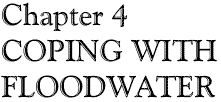
| ch. 4, pp. 41 |
The variety of solutions to flooding problems has improved flood and erosion protection in many areas, but also has affected recharge in rivers. Before urbanization, flood waters spread out over a broad area and moved slowly downstream. This enhanced natural recharge, with more flood waters reaching the aquifer. With waters now often confined within rigid, usually impervious channel walls, much of the water moves swiftly downstream without recharging. Also, more of the desert area now is covered with roads, parking areas, and buildings constructed on land where water once soaked into the soil. Impervious surfaces generally cover approximately 20 percent of a suburban watershed area which usually has two houses or less per acre. In a highly urban watershed impervious surfaces cover approximately 70 percent or more of the surface area. Highly urban watersheds contain six or more houses per acre, and include commercial, industrial and multiple dwelling uses, with extensive drainage improvements. Flowing rapidly and temporarily flooding streets, this water can pick up a wide variety of pollutants, carrying them to rivers. Because of infrequent rains, oil tends to build up on Tucson streets. During the first big storms of summer, Tucson streets tend to be slippery from this oil that flows with the flood waters. More auto accidents occur at this time than later in the rainy season when the streets have been partially cleansed by flowing water. More information is needed to determine whether pollutants in stormwater runoff have a significant impact on groundwater quality. Because of the various urban conditions, less recharge occurs during big storms than would occur if conditions were more natural. Not only is water that could possibly be recharged leaving the area, but some of the stormwater that does recharge may be polluted from urban conditions. Old landfills located along river channels can be the source of further pollution entering the groundwater during flooding.
|
